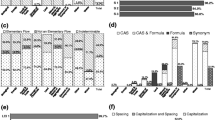Abstract
The reason to perform an LCA is essentially to use it in support of a decision. A decision gives rise to a change somewhere in society compared to a scenario in which this decision was not taken. The key requirement for the LCA in any application is therefore, that it shall reflect the environmental change caused by the decision. It is found, that the need to differentiate LCA methodology for the use in different applications is born by a few key characteristics of the decision to be supported.
The first key characteristic is the environmental consequence of the decision, i.e. the nature and extent of the environmental change caused by the decision. When modelling the environmental change, its extent in time and space will differ between decision types, thus giving rise to different requirements, primarily for the scoping and inventory phases of the LCA. Furthermore, some decisions will imply trade-offs between different impact categories, while others will not, thus causing different requirements for the impact assessment. The second key characteristic is the social and economic consequence of the decision, the magnitude of which will influence the need for certainty, transparency and documentation. The third characteristic is the context in which the decision is taken, including the decision maker and interested parties, implicitly influencing the impact assessment and weighting.
Similar content being viewed by others
References
Baumann H (1995): Decision making and life cycle assessment. Doctoral thesis, Technical Environmental Planning Report 1995:4, Chalmers University of Technology, Gothenburg
COWI (1997): Development of Concept for Comparable Environmental Impact Data on Cleaner Technologies (CEIDOCT). Research and development report, European Environment Agency, Danish Environmental Protection Agency, October 1997
Frischknecht R (1997): Goal and scope definition and inventory analysis. LCANET, Zürich
Förster R (1996): Application dependency of impact assessment methodology. In: Braunschweig et al. Developments in LCA valuation. IWO Diskussionsbeitrag 32, Institut für Wirtschaft und Ökologie, Universität St. Gallen, St. Gallen, Switzerland
ISO (1997): Environmental management — life cycle assessment — principles and framework. ISO 14040, International Organization for Standardisation, Geneva
Lindfors L-G, Christiansen K, Hoffman L, Virtanen Y, Juntilla V, Hanssen O-J, Roenning A andEkvall T (1995): Nordic guidelines on life-cycle assessment. Nordic Council of Ministers, Nord 1995:20, Copenhagen
Weidema B P (1993): Development of a methodology for product Life Cycle Assessment with special emphasis on food products. Summary of Ph.D. thesis, Interdisciplinary Centre, Technical University of Denmark, Lyngby, Denmark
Weidema B P, (1998): Application Typologies for Life Cycle Assessment — A review. Int. J. LCA 3 (4): 237–240
Weidema B P,Frees N andNielsen A-M (1999): Marginal Technologies in Life Cycle Inventories. Int. J. LCA in print
Wenzel H (1994a): Information on spatial detail in LCA — the significance of the LCA application. In: First working document on life- cycle impact assessment methodology. Workshop held at ETH Zurich July 8-9, 1994. ETH, Zürich
Wenzel H (1994b): Structure of valuation step in LCA — the significance of the LCA application. In: First working document on life- cycle impact assessment methodology. Workshop held at ETH Zürich July 8—9, 1994. ETH, Zürich
Wenzel H, Hauschild M andAlting L (1997): Environmental assessment of products, vol. I: Methodology, tools and case studies in product development. Chapman & Hall, London
Author information
Authors and Affiliations
Corresponding author
Rights and permissions
About this article
Cite this article
Wenzel, H. Application dependency of lca methodology: Key variables and their mode of influencing the method. Int. J. LCA 3, 281–288 (1998). https://doi.org/10.1007/BF02979837
Issue Date:
DOI: https://doi.org/10.1007/BF02979837




